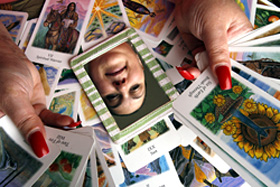 |
 |
 |
 Health & Beauty | August 2007 Health & Beauty | August 2007  
Between Prayers and Herbs
 Ahicsa Muñiz - Odessa American Ahicsa Muñiz - Odessa American
go to original


| | Curanderas, like Sister White Feather, are an important part of Hispanic folk culture. (Cindeka Nealy/Odessa American) |
Most Hispanic people have heard their mother or grandmother say something like “that child caught the evil eye.”

Who can forget chamomile — a necessity in every Hispanic home said to cure a wide range of minor illnesses ranging from “aire” or “bad air” in the body, to nasal congestion.

Certainly, modern medicine is essential, but home remedies reflect the history and beliefs that make Latinos a culture filled with folklore and mysticism. When it comes to home remedies, it is inevitable to talk about the popular “curanderas” or faith healers and “hierberas” or herbalists.

Sister White Feather, a curandera from Odessa CA, says she inherited her knowledge about the spiritual world and healing from her grandmother. She defines herself as a “curandera,” or spiritual healer with a special “don” or gift.

The Encyclopedia of Alternative Medicine defines curanderismo as folk medicine that “blends religious beliefs, faith and prayer with the use of herbs, massage and other traditional methods of healing.” Although curanderas have all these elements at their disposition, Sister White Feather says that there are things in which nobody, except God, can intervene.

“I’ll consult and guide you according to what God dictates me and to the extent that he allows me to,” White Feather said.

“The goal of every curandero is to achieve the person’s wellbeing physically, mentally and spiritually,” she said. “To achieve this I use different objects. My herbs are very important since I prefer the traditional method of healing.”

White Feather’s clientele is varied. “Among my clients there is a mix of Anglos, Hispanics, African-Americans, you name it. However, the majority of my clients are Hispanic because they are the predominant population here.”

This curandera attributes the close relationship that Hispanics have with spiritualism with the fact that Hispanic culture has inherited many of its knowledge from the Aztecs and the Mayas.

Hilda Ortega, owner of the herbal store Sucursal Hierberia Mora, in Ojinaga, Chihuahua, Mexico, says that this tradition has been part of her husband’s family for many years and that she absorbed all that knowledge. In Ortega’s opinion, “prescription medicine makes things worse, it only controls the problem, but it does not get rid of it.”

Besides owning the herbal store, Ortega also works in a pharmacy in the Institute of Social Services for State Workers (ISSTE, for its Spanish acronym). To many, this may sound ironic, but to Ortega this experience has “definitely helped (her) understand and learn more about modern day medication, as well as the damage it causes.”

In a store like Ortega’s, it is not necessary to take a doctor’s prescription or a curandera’s recipe. Ortega says that her workers have the knowledge necessary to recommend or determine a specific remedy for your needs.

“Natural medicine is gentle, that is why people taking it run out of patience when they fail to see immediate results,” Ortega said. To her, “hierberias are fundamental since herbs are the essence of modern day medicine.”

Fervent believers like Nora Aguirre, a 22-year-old UTPB art student regularly visit a curandera for cleansings.

“It is an important part of my life. It really bothers me when people don’t see this with the respect they should,” she said.

Born and raised Catholic, Aguirre visits a curandera monthly. She believes it helps her “take the bad vibes away” and believes it has helped her “get focus, which has lead to more professional and personal achievements.”

Contrary to Aguirre, Sister White Feather and Ortega, Dr. Manuel Jesús Acosta Muñoz, a surgeon specialized in public health in Ojinaga, has very different views about curanderismo.

“Traditional medicine is losing ground to the new scientific and technological advances, gradually substituting superstition for more solid and objective knowledge,” Acosta said.

“Still, the issue is more complicated and interesting than this,” he said. “Traditional medicine is constantly fighting a battle for its credibility due to charlatans. Avoid going to these people that claim to cure every illness.”

But how does a doctor explain the phenomenon of “the evil eye” or a “bad air?”

“These are definitely illnesses that, because of their characteristics and nature, are very common among the population,” Acosta said, adding that for every common illness cured by curanderas there is a scientific explanation. | 
 | |
 |




